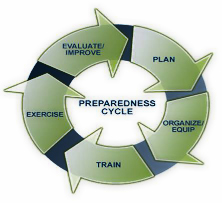It wasn't raining when Noah built the ark. - Richard C. Cushing
We have become accustomed to modern conveniences in our daily lives. Many services are taken for granted that would cause a serious impact to our life's if they were to become unavailable. Could you survive if any of these services or facilities were interrupted during a prolonged emergency ?
- Electricity
- Water
- Natural Gas
- Gasoline and other petroleum fuels
- Banking/ATM's
- Food on the supermarket shelves
- Your home
One of the first steps you should undertake for your emergency planning is to create a list of potential threats.
It might look something like this:
Natural:
- Floods
- Drought
- Winter Storms
- Hurricanes
- Tornadoes
- Heat
- Climate changes
- New diseases
- Wildfire
- Avalanche
- Mud slides
- Earthquakes
- Volcanic activity
- Tsunamis
Man-Made:
- Political Disasters
- Riot
- Marshal law
- Totalitarian government
- Environmental Disasters
- Hazardous Materials spills
- Nuclear material or plant accidents
- Dam failures
- Water/Air pollution
Economic:
- Depression
- Inflation
- Loss of your job/income/home
War:
- Full scale nuclear
- Limited nuclear
- Chemical (haz mat)
- Biological (diseases)
Terrorist Attack:
- Hijacking
- Attacks on infrastructure (water, electricity)
- Hostage taking
- Sabotage (nuclear accidents, haz mat)
Others:
- House damaged by fire or accident
- Robbery
- Burglary
- Car jacking
- Kidnapping
Threat Assement Maps
Unfortunately there is no easy formula for a profile of risk factors.
The links in this section can be used to help identify threats ranging from population centers, military bases, and, critical infrastructure locations at the state level, to tornado, hurricane, and siesmic prone areas at the national level.
State Assessment Maps
Natural Disaster Maps
Technological & Biological Threats
The links in this section can help to identify threats from man made technologies as well as those from biohazardous threats and infectious diseases.
Technological Disasters
Infectious Diseases
Epidemics & Pandemics
Once you have all the possible threats written down, rank them in order of there potential threat. When you have finnished ranking them write down what each threat will mean to you and your lifestyle - what will you have or not have, what will you be able to do or not be able to do, what will you need. An example might look something like this:
Thunder Storm: with electrical outage for 2 (average) to 72 hours (severe).
- Food spoilage
- Loss of air conditioning/furnace
- Damage to property from nearby trees
- Possible flooding
- Lightning damage/fire potential
- Local transportation impaired
You should now have a prioritized list of the potential threats that you could face. With this list, you can start deciding what sorts of preparation you need to do to meet the
threat. When your list is complete, you'll see several materials are needed for many different threats. First aid skills and materials are always useful. Stored food and water might
be needed for many things as well, while having a chainsaw or firearm might only be needed for a few.
Now you have a roadmap of the skills and materials, that you need to become self-reliant. The longer you prepare, the more knowledge you'll decide you'll need. Some examples
that you might decide you need to be proficient in are emergency first aid, food preservation (drying, smoking, canning, pickling), gardening, engine mechanic, construction,
fishing, ham radios, weaving cloth, sewing, tanning leathers, bee keeping, trading, farming, dentistry, childbirth, small military unit tactics, advanced emergency medical
treatment, hunting, trapping, welding, metal working, power generation....


